2018 in Review and Top 25 + 5 Shakespeareances
The Aggregate Experience
In 2018, for the first time in my 61-year life—attending plays in 44 of those years and now having seen 830 staged productions in that span—I walked out of a play at intermission.
It might seem odd to start a commentary about my favorite theater moments of the year with the absolute worst and second worst productions, but it turns out to be instructive of the year I've had: A year in which I traveled coast to coast—corner-to-corner, even—across the North American continent seeing 71 Shakespeare productions at 50 different theaters, plus 12 non-Shakespeare productions. That is the sum total of my successful effort to accomplish the Shakespeare Canon Project to see all 42 William Shakespeare-penned plays at 42 North American theaters in one year.
Ranked number 71 is the William Davenant-adapted Macbeth at the Folger Theatre in Washington, D.C. It hit rock bottom (of all time, not just this year) not because Davenant's adaptation lessened Shakespeare's masterpiece but because Robert Richmond's direction presented the play in a Bedlam framework: The actors played mental institution inmates putting on the play even while being tortured at the back of the stage. After withstanding the insulting spectacle of every drooling, wide-eyed, body-twitching stereotype of mental illness paraded before the audience, I watched the production sink into a confusing mess in which the framework intruded on the play. It also obliviated the project's purpose to explore the staging qualities of Restoration-era Shakespeare adaptations. Such a body of scholarship around Elizabethan and Jacobean texts already have yielded rich rewards in staging the plays of Shakespeare and his contemporaries. The key to both the scholarship and the rewards: it's all based on what's in the texts, not some 21st century imagination.
Second from the bottom of my Shakespeareances in 2018 was Hamlet at Shakespeare Theatre Company, also in Washington, D.C. The production opened with biggish star Michael Urie stepping onto the stage alone and delivering Hamlet's "O, that this too too solid flesh would melt, thaw, and resolve itself into a dew!" The shock of displaced speeches (which happened a couple of times in the Michael Kahn-helmed production) was quickly supplanted by Urie suddenly yelling, wailing, screeching, and flapping about like a flightless bird doing a mating dance. This caffeinated portrayal of Hamlet continued all the way to his last line when the rest was silence, thank God. Kahn's modern setting was fine, but turning the Ghost into an image on a security monitor, generating laughs instead of chills, set the tone for what ultimately proved to be a frustratingly silly production. Ranked number 69 on my list, by the way, was Folger's production of The Winter's Tale, another meandering revisionist effort that didn't even bother to have a bear of any type.
Ironically, the Folger and the Shakespeare Theatre Company (STC) are two of only three companies we subscribe to (and used to be members of)—the other company, American Shakespeare Center in Staunton, Virginia, landed much higher on this year's rankings. I also must report that the STC Hamlet made the Washington Post's top 10 list for the year, so my opinion of its shortcomings are not universally shared. No matter because I'm not here to argue tastes or preferences. I'm here to report on what I've experienced across the North American Shakespearean landscape in 2018.
What I experienced was incredible Shakespeare being staged in all types of venues by all levels of talent in all kinds of communities. You don't have to travel to the great metropolises or famous cultural centers to get your Shakespeare fix, though I also saw great Shakespeare in those places, including in the D.C. area. Just drive down the road.
In fact, the biggest problem I had putting together this year's ranking of top Shakespeareances was ordering the glut of good-to-great work I saw hither and yon. I use a simple standard to come up with my rankings: I pretend I'm at the end of my life and God (or Saint Peter, or maybe Satan, I guess) says, "which of these two things do you want to relive, and you can only choose one." This is merely a tool for choosing this over that and that over this and on to the top of that particular ranking. Some special moments in my life—most involving moments with my wife, Sarah—far outrank any theater experiences I've had, this year or any year.
Significantly, this is not an intellectual exercise; it's a holistic experience exercise. In fact, the first thing I had to do in ranking this year's Shakespeareances was limit the experiences to only attending productions and isolating that from everything else involved with visiting the theater. On my Canon Project travels, my hosts bent over backward with hospitality, including hundreds of interviews with company members. I tried not to let that influence my ratings of the productions. Even so, I found that other than the few at the top and the three at the bottom, the separation between, 10 and 60 is minimal. At my death I'd ask God or Saint Peter or Satan, can I just do the entire Canon Project again (after, of course, those dozen or so, um, moments with Sarah, and the Jordan Zimmerman no-hitter)? Indeed, some of my favorite theater companies didn't make the Top 25—and I was shocked to see that.
That shock admits my own snobbery. When I was in St. John's, Newfoundland, I was interviewed on local radio and the company treated me as a special honored guest because I traveled there all the way from Washington, D.C., to see an amateur Shakespeare production. To that I answer, I saw better Shakespeare there than some of what I saw here in D.C.
In the aggregate—in organizing these rankings and through what I experienced over the course of the year—I came to realize that the primary determiner of good versus not so good is textual fealty. I found that those productions that focused on the text for its direction, thematic essence, and character palette were far more entertaining than those that did not. I've resisted the label of being a purist—after all, Othello: The Remix is one of my favorite all-time Shakespeare productions, and you'll see a couple of adaptations high up on this year's list. Maybe the phrase I should use is respect the text. Those who trust Shakespeare to deliver the goods inevitably get the goods. Those who don't—well, let's just say the outcome is not as inevitable.
The strongest evidence supporting this finding resides in Round Top, a town with a population of 91 in the heart of Texas. On my travels, I often was asked, "What's the best you've seen so far?" and though I could list off this play or that play even early in the year, I kept coming back to the experience of Shakespeare at Winedale. It is a University of Texas English Department program that studies Shakespeare's works through performing them. Most of the students are English, communications, or history majors; only two in last summer's session were acting students. They get a crash-course in verse work and then, collaboratively, mount four plays for a repertory season in a ramshackle 19th century barn with guidance (but not direction) from professors and teaching assistants. No Tony-caliber talents here: a couple actors did no better than monotone deliveries, a couple overly mugged, most were adequate, and a couple were outstanding. The overall productions, though, were completely fulfilling on their own merits, and one in particular stresses my point. I saw several Love's Labour's Losts this year, and Winedale's is my highest ranking production of that title (though not the highest Winedale ranking on the list below). Nor was the competition for that play even close: I answered God, Saint Peter, and Satan without pause. I believe the key was that these amateur actors were all directed solely by the text and no other extracurricular concept. That format of actors working collaboratively from the text, incidentally, is how the American Shakespeare Center's Actors' Renaissance Season company works (and see how high they rank below). There's a lesson there for the well-endowed Shakespeare institutions of this land.
And yet, the top spot for my 2018 Shakespeareances has nothing to do with textual fealty, talent level, production quality, or theoretical application. It does have everything to do with live theater, Shakespeare, and America. It also has everything to do with 2018. In a year in which our body politics on both sides of the U.S.–Canada border have dealt with so much fear and frustration, my number one Shakespeareances for 2018 illustrates how we can always find a light in the darkness. Maybe just a pinprick light, but…
Top 25 Shakespeareances of 2018
- A Midsummer Night's Dream, Independent Shakespeare Company, Los Angeles, California. This production in Griffith Park would have made this list's top 10 in its own right. David Melville with his suave, faux sophistication was one of the most singularly funny Bottoms I've yet seen. Julia Aks combined Valley Girl phrasings to her line readings with a thrilling track-and-field athleticism in her portrayal of Helena. The strong ensemble maintained a casual repartee with the hillside audience (Kelvin Morales' Puck looking for an Athenian among us), and Director Melissa Chalsma achieved an easy-flowing arc for all four elements of Shakespeare's play: the rude mechanicals, the lovers, and the royal Athenians doubling as the royal fairies. Nevertheless, it was a catastrophic failure in production values on the last night of the play's run that created theater magic. A faltering Los Angeles power grid had already delayed the show's start, and the play proceeded on reduced electrical juice with all ancillary lighting extinguished and only work lights for the stage. The actors made do with flashlights and miner's headlamps as they entered and exited through the audience. Just as Aks started into Helena's "spaniel" speech, the scant stage lights flickered and went out, plunging Griffith Park into complete darkness. Aks continued her lines even as a collective "uh-oh" murmured through the audience. Then, that audience took out cell phones and flashlights and aimed them at the stage. "Light me up, Los Angeles!" Aks shouted, and a couple thousand Los Angelinos did just that, creating a galaxy of pinprick lights to provide just enough
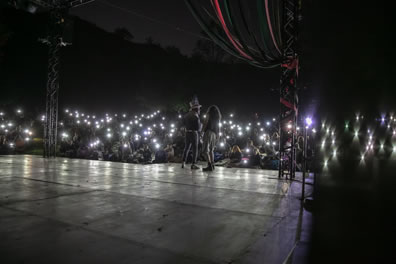 glow for the scene to continue, Demetrius running off with Helena chasing him and Puck giving Oberon the magic flower who then describes a bank where the wild thyme blows. After about five minutes, the stage lights came back on, and though the moment was past, the magic lingered, on through the rude mechanicals' Bergomask, danced to the old R&B tune, "Stand By Me" (look up the lyrics). Over the year of traveling across the continent for the Shakespeare Canon Project, I encountered much frustration, disappointment, anger, fear, and trepidation prompted by the political turmoil in both the United States and Canada. And I encountered this moment. It's no trick: the magic behind the moment is Shakespeare and live theater, yes, but most of all it's the shared value of community that makes us so rich. Shakespeare asks through this play, do you believe in magic? Yes.
glow for the scene to continue, Demetrius running off with Helena chasing him and Puck giving Oberon the magic flower who then describes a bank where the wild thyme blows. After about five minutes, the stage lights came back on, and though the moment was past, the magic lingered, on through the rude mechanicals' Bergomask, danced to the old R&B tune, "Stand By Me" (look up the lyrics). Over the year of traveling across the continent for the Shakespeare Canon Project, I encountered much frustration, disappointment, anger, fear, and trepidation prompted by the political turmoil in both the United States and Canada. And I encountered this moment. It's no trick: the magic behind the moment is Shakespeare and live theater, yes, but most of all it's the shared value of community that makes us so rich. Shakespeare asks through this play, do you believe in magic? Yes.
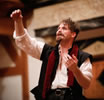 Hamlet, American Shakespeare Center, Staunton, Virginia. Reading Hamlet for a college course was my moment of Shakespeare addiction. I was blown away by the wordcraft, the thriller plot, the vivid characters, the psychological wrangling, and, my god, his employment of poetic imagery in achieving all the above. This Blackfriars Playhouse performance was the 24th stage production of Hamlet I've seen (along with a half dozen films), but the first time I relived reading the play that first time 41 years ago. This staging was accomplished by 12 actors who had two weeks to mount this and another play (Richard II) without a director as part of the Actors' Renaissance Season. Josh Innerst sits among the great Hamlets I've seen, but the real star was the ensemble, a collaborative team of actors who created the most thematically and dramatically cohesive Hamlet I've ever seen, one that put me inside the story and its characters' lives. Immersive theater at its best.
Hamlet, American Shakespeare Center, Staunton, Virginia. Reading Hamlet for a college course was my moment of Shakespeare addiction. I was blown away by the wordcraft, the thriller plot, the vivid characters, the psychological wrangling, and, my god, his employment of poetic imagery in achieving all the above. This Blackfriars Playhouse performance was the 24th stage production of Hamlet I've seen (along with a half dozen films), but the first time I relived reading the play that first time 41 years ago. This staging was accomplished by 12 actors who had two weeks to mount this and another play (Richard II) without a director as part of the Actors' Renaissance Season. Josh Innerst sits among the great Hamlets I've seen, but the real star was the ensemble, a collaborative team of actors who created the most thematically and dramatically cohesive Hamlet I've ever seen, one that put me inside the story and its characters' lives. Immersive theater at its best.
- Henry V, Shaw Festival, Niagara-on-the-Lake, Ontario. Seven World War I soldiers enter their dugout after a patrol. They relax, clean their equipment, and begin performing Shakespeare's Henry V for their own amusement. In the middle of the Katherine/Alice scene, they break off at the sound of artillery, load up, and march out. Intermission. In the second half, six of the soldiers, one catatonic, lie in hospital beds, and the nurses pick up with the Katherine/Alice scene and the five guys capable of continuing resume their roles (or take on the roles of those missing or unable). In this production directed by Kevin Bennett and Tim Carroll, Henry V seamlessly integrates with the framework device to become something more deeply resonating as both an epic hero's tale and a national tragedy. A stunning piece of work.
 Twelfth Night, Fiasco Theater, Classic Stage Company, New York, New York. Four more actors than they normally employ (for a cast of 10) and a prop-loaded set rather than a bare stage: Fiasco didn't let these luxuries get in the way of what they do so well, present Shakespeare with detail-rich performances in a theater-as-community environment. We could feel—not merely see—the exact moment the heart of Jessie Austrian's Olivia goes racing ahead of her brain, and Ben Steinfeld's Feste straddled the so-called fourth wall. Warm-hearted, intelligent, and brilliantly acted, this Twelfth Night cements Fiasco's place among the world's elite Shakespearean practitioners.
Twelfth Night, Fiasco Theater, Classic Stage Company, New York, New York. Four more actors than they normally employ (for a cast of 10) and a prop-loaded set rather than a bare stage: Fiasco didn't let these luxuries get in the way of what they do so well, present Shakespeare with detail-rich performances in a theater-as-community environment. We could feel—not merely see—the exact moment the heart of Jessie Austrian's Olivia goes racing ahead of her brain, and Ben Steinfeld's Feste straddled the so-called fourth wall. Warm-hearted, intelligent, and brilliantly acted, this Twelfth Night cements Fiasco's place among the world's elite Shakespearean practitioners.
- Arden of Faversham, Shakespeare at Winedale, Round Top, Texas. Universityof Texas students (only two on
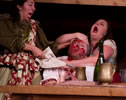 acting tracks) collaboratively staging this apocryphal piece (and three other Shakespeare plays) prove its entertainment value. Raucous comedy and vivid characters color this true-life crime drama, and the company plays to the hilt all the bungled attempts to murder Arden. With the murder scene itself, the ensemble uses the script's three murder weapons as an excuse to kill Arden three times—the guy just won't stay down. The tour de force performance had the audience shrieking in a combination of horror and laughter, and me wishing I could see this production again and again and again.
acting tracks) collaboratively staging this apocryphal piece (and three other Shakespeare plays) prove its entertainment value. Raucous comedy and vivid characters color this true-life crime drama, and the company plays to the hilt all the bungled attempts to murder Arden. With the murder scene itself, the ensemble uses the script's three murder weapons as an excuse to kill Arden three times—the guy just won't stay down. The tour de force performance had the audience shrieking in a combination of horror and laughter, and me wishing I could see this production again and again and again.
 Drunken Shakespeare, The Night Shift, New York, New York. This might stand as my only chance to see performed live the Shakespeare-penned speech on immigration in Sir Thomas More—and a shivering rendition by my son Jonathan, at that. It's likely the only time I'll see Calaban played as Gollum, Macbeth's "tomorrow" speech delivered in 14 different voices (from Jeff Goldblum to Arnold Schwarzenegger), a Phoebe so schizophrenically funny and a Portia so achingly real, or Hamlet's speaking "To be or not to be" like a somewhat drunk guy in a bar—which is exactly what he was at that point. This Shakespeare karaoke experience was tremendous fun and stellar Shakespeare.
Drunken Shakespeare, The Night Shift, New York, New York. This might stand as my only chance to see performed live the Shakespeare-penned speech on immigration in Sir Thomas More—and a shivering rendition by my son Jonathan, at that. It's likely the only time I'll see Calaban played as Gollum, Macbeth's "tomorrow" speech delivered in 14 different voices (from Jeff Goldblum to Arnold Schwarzenegger), a Phoebe so schizophrenically funny and a Portia so achingly real, or Hamlet's speaking "To be or not to be" like a somewhat drunk guy in a bar—which is exactly what he was at that point. This Shakespeare karaoke experience was tremendous fun and stellar Shakespeare.
 Coriolanus, Brave Spirits Theatre, Alexandria, Virginia. In the crowded lobby, people in postapocalyptic clothes and makeup began milling angrily about, muttering about corn. They were about to break out into all-out rebellion—right there among us. Then came Meneneus, then Caius Martius, then news of the Volsces, and then we headed into the theater, but were stalled in the hall by the two tribunes. This arresting opening led into a play that evolved among and around us with a dynamic that was not only dramatic but also germane to the play's themes and imagery. This was another piece of great visionary theater from Director Charlene V. Smith and her cast of Brave Spirits actors.
Coriolanus, Brave Spirits Theatre, Alexandria, Virginia. In the crowded lobby, people in postapocalyptic clothes and makeup began milling angrily about, muttering about corn. They were about to break out into all-out rebellion—right there among us. Then came Meneneus, then Caius Martius, then news of the Volsces, and then we headed into the theater, but were stalled in the hall by the two tribunes. This arresting opening led into a play that evolved among and around us with a dynamic that was not only dramatic but also germane to the play's themes and imagery. This was another piece of great visionary theater from Director Charlene V. Smith and her cast of Brave Spirits actors.
 Measure for Measure, American Players Theatre, Spring Green, Wisconsin. Merely staging this play in 2018 could land it in the top 10, but Director Risa Brainin nailed the relevance with a modern-dress, text-centric production that didn't point fingers at any contemporary villains other than a faltering political system. Casting Latinx actors to play Isabella, Claudio, and Julia, and depicting the guards as ICE agents expanded the themes of good-vs-bad governance beyond the #MeToo movement. Brainin also worked the ending into a scene of inclusion rather than a plot-confounding conundrum. Credit to Rudy Guliani, too, for giving Isabella's line, "truth is the truth to th'end of reck'ning," instant relevance.
Measure for Measure, American Players Theatre, Spring Green, Wisconsin. Merely staging this play in 2018 could land it in the top 10, but Director Risa Brainin nailed the relevance with a modern-dress, text-centric production that didn't point fingers at any contemporary villains other than a faltering political system. Casting Latinx actors to play Isabella, Claudio, and Julia, and depicting the guards as ICE agents expanded the themes of good-vs-bad governance beyond the #MeToo movement. Brainin also worked the ending into a scene of inclusion rather than a plot-confounding conundrum. Credit to Rudy Guliani, too, for giving Isabella's line, "truth is the truth to th'end of reck'ning," instant relevance.
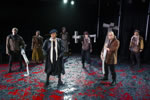 Henry VI, National Asian American Theatre Company, New York, New York. What makes this production's ranking significant is that I prefer my Henry VI plays singly, not conflated. Stephen Brown-Fried adapted Shakespeare's trilogy into two plays that honed key character arcs and then directed a talented ensemble that delivered powerful performances. Mahira Kakkar worked Queen Margaret's pride and insecurities into a single dynamic portrayal, and her bloody napkin scene with Rajesh Bose's York gets my heart pounding just writing this. Jon Norman Schneider turned the titular Henry into a real force, perhaps ill-equipped to rule but nevertheless bringing all his moral and emotional strength to the game.
Henry VI, National Asian American Theatre Company, New York, New York. What makes this production's ranking significant is that I prefer my Henry VI plays singly, not conflated. Stephen Brown-Fried adapted Shakespeare's trilogy into two plays that honed key character arcs and then directed a talented ensemble that delivered powerful performances. Mahira Kakkar worked Queen Margaret's pride and insecurities into a single dynamic portrayal, and her bloody napkin scene with Rajesh Bose's York gets my heart pounding just writing this. Jon Norman Schneider turned the titular Henry into a real force, perhaps ill-equipped to rule but nevertheless bringing all his moral and emotional strength to the game.
 Othello, Baltimore Shakespeare Factory, Baltimore, Maryland. Already, Ian Blackwell Rogers' Iago had me in his spell. Then, Troy Jennings as Othello walked on stage, and even before he spoke I was filled with awe in his presence. Then he did speak—in Original Pronunciation—and I joined Desdemona, the Duke and his council, and countless others smitten by this Othello's muscular musicality, warrior bearing, and genial expression. This young (in his 20s) Othello drove the tragedy in a richly insightful staging by Baltimore Shakespeare Factory Founding Artistic Director Tom Delise, played with textual honesty by an accomplished cast using Original Pronunciation.
Othello, Baltimore Shakespeare Factory, Baltimore, Maryland. Already, Ian Blackwell Rogers' Iago had me in his spell. Then, Troy Jennings as Othello walked on stage, and even before he spoke I was filled with awe in his presence. Then he did speak—in Original Pronunciation—and I joined Desdemona, the Duke and his council, and countless others smitten by this Othello's muscular musicality, warrior bearing, and genial expression. This young (in his 20s) Othello drove the tragedy in a richly insightful staging by Baltimore Shakespeare Factory Founding Artistic Director Tom Delise, played with textual honesty by an accomplished cast using Original Pronunciation.
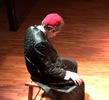 The Merchant of Venice, Children's Shakespeare Theatre, Palisades, New York. I've seen better overall productions of The Merchant of Venice, but none so socially revealing and hilarious at the same time. Being performed by grade and middle school kids directed by Children's Shakespeare Theatre's Founding Artistic Director Diana Green brought out the rampant bullying the play portrays while keeping the comedy front and center, especially in superlative comic performances by Adam Greenberg as Gratiano and Liam Rigney as Launcelot. Cooper Rossen's Shylock so fixated on his bond that the word's multiple meanings emerged, showing how society relies on bonds of all types to succeed.
The Merchant of Venice, Children's Shakespeare Theatre, Palisades, New York. I've seen better overall productions of The Merchant of Venice, but none so socially revealing and hilarious at the same time. Being performed by grade and middle school kids directed by Children's Shakespeare Theatre's Founding Artistic Director Diana Green brought out the rampant bullying the play portrays while keeping the comedy front and center, especially in superlative comic performances by Adam Greenberg as Gratiano and Liam Rigney as Launcelot. Cooper Rossen's Shylock so fixated on his bond that the word's multiple meanings emerged, showing how society relies on bonds of all types to succeed.
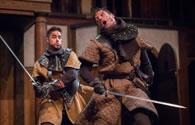 Henry IV, Part One, Atlanta Shakespeare Company, Atlanta, Georgia. This Jeff Watkins–helmed Shakespeare Tavern Playhouse staging unleashed everything that makes this one of my two favorite plays: the rich palette of characters, the character-driven comedy, Prince Hal's psychological journey (played by Jonathan Horne), and Hotspur in all his dimensions (played by Chris Hecke). I could count on both Watkins—the purest of Shakespeareans—and J. Tony Brown, who has played Falstaff some dozen times, to deliver, and then Fight Director Drew Reeves put the final stamp of greatness on this production by choreographing a five-minute Hal-vs-Hotspur donnybrook with a final stab so realistic doctors rushed the stage.
Henry IV, Part One, Atlanta Shakespeare Company, Atlanta, Georgia. This Jeff Watkins–helmed Shakespeare Tavern Playhouse staging unleashed everything that makes this one of my two favorite plays: the rich palette of characters, the character-driven comedy, Prince Hal's psychological journey (played by Jonathan Horne), and Hotspur in all his dimensions (played by Chris Hecke). I could count on both Watkins—the purest of Shakespeareans—and J. Tony Brown, who has played Falstaff some dozen times, to deliver, and then Fight Director Drew Reeves put the final stamp of greatness on this production by choreographing a five-minute Hal-vs-Hotspur donnybrook with a final stab so realistic doctors rushed the stage.
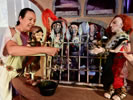 Titus A. puppet revenge, Shakespeare on the Saskatchewan, Saskatoon, Saskatchewan. Using puppets to present TitusAndronicus has obvious benefits: you can do to puppets all the anatomical mutilation depicted in this play that you cannot do to Equity actors, and throw in some graphic sex on the side, too (Tamora giving Aaron a blow job during his conspiracy speech). Puppets also tug at human emotions as no human can. The ravished and mutilated Lavinia lying on the table as puppeteers helplessly watched her struggle back to life punched my gut more painfully than bloody stumps or red ribbons ever could.
Titus A. puppet revenge, Shakespeare on the Saskatchewan, Saskatoon, Saskatchewan. Using puppets to present TitusAndronicus has obvious benefits: you can do to puppets all the anatomical mutilation depicted in this play that you cannot do to Equity actors, and throw in some graphic sex on the side, too (Tamora giving Aaron a blow job during his conspiracy speech). Puppets also tug at human emotions as no human can. The ravished and mutilated Lavinia lying on the table as puppeteers helplessly watched her struggle back to life punched my gut more painfully than bloody stumps or red ribbons ever could.
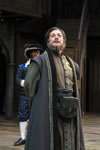 The Merchant of Venice, Utah Shakespeare Festival, Cedar City, Utah. Lisa Wolpe walked on stage and said, "Three thousand ducats; well." I was instantly enthralled. The bearded Wolpe was Shylock, and the theater was hers. Other elements of Melinda Pfundstein's production legitimately wrested the play into the realm of comedy, especially Portia's suitors and the superior comic talents playing Nerissa (Betsy Mugavero) and Gratiano (Josh Innerst), but Wolpe kept delivering such nuanced meanings in Shylock's lines to make him a true, tragic hero without excessive pathos. "I—am—content," she said speaking it as a quiet wail, and in the spaces between words was deep understanding more than resignation.
The Merchant of Venice, Utah Shakespeare Festival, Cedar City, Utah. Lisa Wolpe walked on stage and said, "Three thousand ducats; well." I was instantly enthralled. The bearded Wolpe was Shylock, and the theater was hers. Other elements of Melinda Pfundstein's production legitimately wrested the play into the realm of comedy, especially Portia's suitors and the superior comic talents playing Nerissa (Betsy Mugavero) and Gratiano (Josh Innerst), but Wolpe kept delivering such nuanced meanings in Shylock's lines to make him a true, tragic hero without excessive pathos. "I—am—content," she said speaking it as a quiet wail, and in the spaces between words was deep understanding more than resignation.
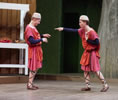 The Comedy of Errors, Kentucky Shakespeare Festival, Louisville, Kentucky. Dathan Hooper stole the show as the Officer in this Shakespeare in the park production. Hooded and speaking one line, his tearful devotion to Egeon in the first scene and childish antics in the final scene had us in stitches. Hooper is a veteran actor playing Othello in this repertory, and that points to the deep talent pool that was this Kentucky Shakespeare Festival company, which delivered Matt Wallace's Bugs Bunny–styled Comedy of Errors with intelligent verse work and sharp physical skill. Only-here highlight: Crystian Wiltshire's Antipholus of Syracuse sightseeing in Ephesus marveling at a low-flying UPS jetliner.
The Comedy of Errors, Kentucky Shakespeare Festival, Louisville, Kentucky. Dathan Hooper stole the show as the Officer in this Shakespeare in the park production. Hooded and speaking one line, his tearful devotion to Egeon in the first scene and childish antics in the final scene had us in stitches. Hooper is a veteran actor playing Othello in this repertory, and that points to the deep talent pool that was this Kentucky Shakespeare Festival company, which delivered Matt Wallace's Bugs Bunny–styled Comedy of Errors with intelligent verse work and sharp physical skill. Only-here highlight: Crystian Wiltshire's Antipholus of Syracuse sightseeing in Ephesus marveling at a low-flying UPS jetliner.
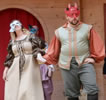 Much Ado About Nothing, Pigeon Creek Shakespeare, The Rose, Blue Lake Arts Camp, Michigan. Just seeing a play in this re-creation of an Elizabethan theater in the middle of a wilderness arts camp would merit the term indelible, but I'd love to watch this Alisha Huber–helmed production by the touring Pigeon Creek Shakespeare company again in any venue. Anchored by Kathleen Bode as Beatrice and Brad Sytsma as Benedick, this Much Ado mined the play's psychological tapestry to deliver authentic character-driven comedy and heartfelt drama. Meanwhile, Scott Wright, playing within the scope of his lines, was as good a Dogberry as I've ever seen.
Much Ado About Nothing, Pigeon Creek Shakespeare, The Rose, Blue Lake Arts Camp, Michigan. Just seeing a play in this re-creation of an Elizabethan theater in the middle of a wilderness arts camp would merit the term indelible, but I'd love to watch this Alisha Huber–helmed production by the touring Pigeon Creek Shakespeare company again in any venue. Anchored by Kathleen Bode as Beatrice and Brad Sytsma as Benedick, this Much Ado mined the play's psychological tapestry to deliver authentic character-driven comedy and heartfelt drama. Meanwhile, Scott Wright, playing within the scope of his lines, was as good a Dogberry as I've ever seen.
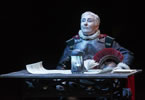 Julius Caesar, Stratford Festival, Stratford, Ontario. It may seem counterintuitive, but if you want to use Julius Caesar to depict Trump, Obama, Pelosi, McConnell, Sessions, and Sanders, don't dress them in red ties, off-the-rack suits, or other modern trappings. Director Scott Wentworth dressed his production exactly as Shakespeare did his (based on the text) to reveal both the ancient story's timelessness and the universal application of its various antagonists. In a well-acted staging that deliberately strove for gender-parity casting, Seana McKenna was such a commanding Caesar that her portrayal proved omnipresent not only in the realm of the production but in the state of our 2018 experience.
Julius Caesar, Stratford Festival, Stratford, Ontario. It may seem counterintuitive, but if you want to use Julius Caesar to depict Trump, Obama, Pelosi, McConnell, Sessions, and Sanders, don't dress them in red ties, off-the-rack suits, or other modern trappings. Director Scott Wentworth dressed his production exactly as Shakespeare did his (based on the text) to reveal both the ancient story's timelessness and the universal application of its various antagonists. In a well-acted staging that deliberately strove for gender-parity casting, Seana McKenna was such a commanding Caesar that her portrayal proved omnipresent not only in the realm of the production but in the state of our 2018 experience.
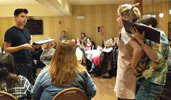 Romeo and Juliet: Choose Your Own Ending, Valley Shakespeare Festival, Shelton, Connecticut. This production at Tavern 1757 was intended as "wacky" fun (Director Tom Simonetti's word) for bar patrons. However, the script by Ann and Shawn Fraistat, which pauses three times for the audience to vote on Romeo's next decision, is a clever commentary on the conventions and traditions of Shakespeare's play (and his other works). Despite 2 1/2 days of rehearsal (of eight potential endings) and with scripts in hand, the six-person cast created indelible characters in a one-night-only production. Fortunately, the audience's votes led to the "flurple" ending, which, on its own, boosts this ranking a couple notches.
Romeo and Juliet: Choose Your Own Ending, Valley Shakespeare Festival, Shelton, Connecticut. This production at Tavern 1757 was intended as "wacky" fun (Director Tom Simonetti's word) for bar patrons. However, the script by Ann and Shawn Fraistat, which pauses three times for the audience to vote on Romeo's next decision, is a clever commentary on the conventions and traditions of Shakespeare's play (and his other works). Despite 2 1/2 days of rehearsal (of eight potential endings) and with scripts in hand, the six-person cast created indelible characters in a one-night-only production. Fortunately, the audience's votes led to the "flurple" ending, which, on its own, boosts this ranking a couple notches.
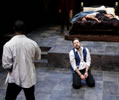 Othello, Utah Shakespeare Festival, Cedar City, Utah. This play's plot is so economical in structure, much of the tragic consequences focuses on the triangle of Othello-Desdemona-Iago. That centerpiece was strong in Kate Buckley's studio theater production with brilliant performances by Wayne T. Carr (Othello), Betsy Mugavero (Desdemona), and Iago (Brian Vaughn), but they didn't monopolize the tragedy. We also felt the pain of Katie Cunningham's Emilia, Brandon Burk's Roderigo, Jeb Burris's Cassio, Jamil Zraikat's Montano, and, most tellingly, Paul Michael Sandberg's Brabantio. An emotionally wringing production.
Othello, Utah Shakespeare Festival, Cedar City, Utah. This play's plot is so economical in structure, much of the tragic consequences focuses on the triangle of Othello-Desdemona-Iago. That centerpiece was strong in Kate Buckley's studio theater production with brilliant performances by Wayne T. Carr (Othello), Betsy Mugavero (Desdemona), and Iago (Brian Vaughn), but they didn't monopolize the tragedy. We also felt the pain of Katie Cunningham's Emilia, Brandon Burk's Roderigo, Jeb Burris's Cassio, Jamil Zraikat's Montano, and, most tellingly, Paul Michael Sandberg's Brabantio. An emotionally wringing production.
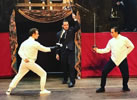 The Fencing Duel, Hamlet, Shakespeare Miami, Pinecrest Gardens, Pinecrest, Florida. Shakespeare Miami is a community theater company with big ambitions. Though its Hamlet was somewhat uneven, the play's Hamlet, Seth Trucks, fully grasped his character's psychological state, giving depth to the part's iconic moments. Then came his epic duel with Laertes (Lito Becerra), simply the best piece of stage combat I've ever seen: exquisite fencing imbued with the personalities of Trucks' feigning-mad Hamlet and Becerra's feigning-courteous Laertes, building in intensity and violence into increasingly desperate swordplay and punches up and down and across the set.
The Fencing Duel, Hamlet, Shakespeare Miami, Pinecrest Gardens, Pinecrest, Florida. Shakespeare Miami is a community theater company with big ambitions. Though its Hamlet was somewhat uneven, the play's Hamlet, Seth Trucks, fully grasped his character's psychological state, giving depth to the part's iconic moments. Then came his epic duel with Laertes (Lito Becerra), simply the best piece of stage combat I've ever seen: exquisite fencing imbued with the personalities of Trucks' feigning-mad Hamlet and Becerra's feigning-courteous Laertes, building in intensity and violence into increasingly desperate swordplay and punches up and down and across the set.
 Love's Labour's Lost, Shakespeare at Winedale, Round Top, Texas. Even the best professionals have trouble corralling this play, with its obtuse humor and complicated nonplot. Leave it to a company of amateur actors—University of Texas students participating in an English lab class studying Shakespeare through performance—to deliver an enlightened production with traces of Will Kemp in Costard (David Higbee Williams) and mirror performances in Don Armado (Natasha Sabour) and Holofernes (Carson Crow). I'll quote directly from my real-time notes: "This has been a most pleasant, at times hugely hilarious production, and yet it ends on a mellow note, pitch perfect in execution."
Love's Labour's Lost, Shakespeare at Winedale, Round Top, Texas. Even the best professionals have trouble corralling this play, with its obtuse humor and complicated nonplot. Leave it to a company of amateur actors—University of Texas students participating in an English lab class studying Shakespeare through performance—to deliver an enlightened production with traces of Will Kemp in Costard (David Higbee Williams) and mirror performances in Don Armado (Natasha Sabour) and Holofernes (Carson Crow). I'll quote directly from my real-time notes: "This has been a most pleasant, at times hugely hilarious production, and yet it ends on a mellow note, pitch perfect in execution."
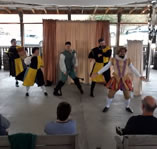 The Two Gentlemen of Verona, Tennessee Shakespeare Company, Memphis, Tennessee. The real train arriving at the climax of The Two Gentlemen of Verona as Tennessee Shakespeare's Shout-Out tour company performed on the patio of Memphis's Wiseacre Brewery certainly was a singular Shakespeareance. Tour Manager Carmen-maria Mandley yelled "TRAIN!" and the cast danced until the last car passed: tap, Irish jig, locomotive with members of the audience. Yet, this ranking is based on the Stephanie Shine-directed troupe's fun comic performances (especially Mandley channeling Lou Costello), and the boy-band-inspired "Who Is Sylvia?" which rivals Arden's death as my favorite staged moment of the year.
The Two Gentlemen of Verona, Tennessee Shakespeare Company, Memphis, Tennessee. The real train arriving at the climax of The Two Gentlemen of Verona as Tennessee Shakespeare's Shout-Out tour company performed on the patio of Memphis's Wiseacre Brewery certainly was a singular Shakespeareance. Tour Manager Carmen-maria Mandley yelled "TRAIN!" and the cast danced until the last car passed: tap, Irish jig, locomotive with members of the audience. Yet, this ranking is based on the Stephanie Shine-directed troupe's fun comic performances (especially Mandley channeling Lou Costello), and the boy-band-inspired "Who Is Sylvia?" which rivals Arden's death as my favorite staged moment of the year.
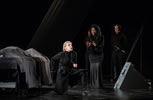 Richard III, upstart crow collective, Seattle Shakespeare, Seattle, Washington. Lit only by flashlights, Sarah Harlett's Richard appears out of the darkness as cast members' handsposition her legs, arms, and body. In this way she moves to a microphone at the front of the stage and delivers the play's famous opening soliloquy. Rosa Joshi's modern-dress, all-female production poignantly presents how society creates and abets its monsters before subsequently suffering the consequences and then forging a savior(?) out of the chaos. Along the way, we get brilliant performances from Chantal De Groat as a politically vicious Hastings and Suzanne Bouchard playing Buckingham as an efficiently subtle spinmaster.
Richard III, upstart crow collective, Seattle Shakespeare, Seattle, Washington. Lit only by flashlights, Sarah Harlett's Richard appears out of the darkness as cast members' handsposition her legs, arms, and body. In this way she moves to a microphone at the front of the stage and delivers the play's famous opening soliloquy. Rosa Joshi's modern-dress, all-female production poignantly presents how society creates and abets its monsters before subsequently suffering the consequences and then forging a savior(?) out of the chaos. Along the way, we get brilliant performances from Chantal De Groat as a politically vicious Hastings and Suzanne Bouchard playing Buckingham as an efficiently subtle spinmaster.
 Macbeth, Chicago Shakespeare Theater on Navy Pier, Chicago, Illinois. Shakespeare's text was trampled some in this remount of the Folger production of 10 years ago, but the magic tricks by Teller, co-directing with Aaron Posner, were still amazing, and Ian Merrill Peakes returned to the role wiser (as an actor) and more vulnerable (as a character), and in another good marital pairing, this time Chaon Cross playing Lady Macbeth. The bigger thrill in this remount, though, was the Weird Sisters, congregating at key points of the play to watch the wreckage develop (without necessarily driving it) while providing an eerie soundtrack through their vocals.
Macbeth, Chicago Shakespeare Theater on Navy Pier, Chicago, Illinois. Shakespeare's text was trampled some in this remount of the Folger production of 10 years ago, but the magic tricks by Teller, co-directing with Aaron Posner, were still amazing, and Ian Merrill Peakes returned to the role wiser (as an actor) and more vulnerable (as a character), and in another good marital pairing, this time Chaon Cross playing Lady Macbeth. The bigger thrill in this remount, though, was the Weird Sisters, congregating at key points of the play to watch the wreckage develop (without necessarily driving it) while providing an eerie soundtrack through their vocals.
 The Two Noble Kinsmen, Kingsmen Shakespeare Festival, Thousand Oaks, California. All is ceremony and mighty speeches as Greek theater meets late Shakespeare in Elizabeth Swain's production. Even when the titular noble kinsmen, Arcite (Connor Sullivan) and Palamon (Rafael Goldstein) are nobly imprisoned after fighting nobly in war against Theseus, they talk nobly of turning their state into the essence of nobility. Then they spy Emilia through the window and both fall in love. "I saw her first," Palamon says, Goldstein giving just the right comic timing, and suddenly this ultraformal play becomes rip-roaring dramady with poignant #MeToo underpinnings.
The Two Noble Kinsmen, Kingsmen Shakespeare Festival, Thousand Oaks, California. All is ceremony and mighty speeches as Greek theater meets late Shakespeare in Elizabeth Swain's production. Even when the titular noble kinsmen, Arcite (Connor Sullivan) and Palamon (Rafael Goldstein) are nobly imprisoned after fighting nobly in war against Theseus, they talk nobly of turning their state into the essence of nobility. Then they spy Emilia through the window and both fall in love. "I saw her first," Palamon says, Goldstein giving just the right comic timing, and suddenly this ultraformal play becomes rip-roaring dramady with poignant #MeToo underpinnings.
Honorable Mentions:
Top 5 Non-Shakespearean Theatrical Moments of 2018
 The Gospel at Colonus, WSC Avant Bard, Arlington, Virginia. Is this theater? Or is this religion? It is both, ingeniously so, as Lee Breuer and Bob Telson adapted Sophocles' Oedipus at Colonus into a Pentacostal service. Black preaching and singing is in itself great theater, and WSC Avant Bard wisely deferred to experts in those mediums for staging this play. While the Sophocles masterpiece gets you thinking (especially with its relevance to today's politics), William T. Newman Jr. as Preacher Oedipus gets you moving, Minister Becky Sanders and The Women's Ecumenical Choir gets you swaying, Kenton Rogers as Singer Oedipus gets you goosebumping, and Rafealito Ross with his lyric tenor singing gets you dabbing at the tears heading for your cheeks. I have only one word for a production staged so well that, after 20 years hoping to see it in person, I got a second-chance gift to see it when Avant Bard revived it this year: Hallelujah!
The Gospel at Colonus, WSC Avant Bard, Arlington, Virginia. Is this theater? Or is this religion? It is both, ingeniously so, as Lee Breuer and Bob Telson adapted Sophocles' Oedipus at Colonus into a Pentacostal service. Black preaching and singing is in itself great theater, and WSC Avant Bard wisely deferred to experts in those mediums for staging this play. While the Sophocles masterpiece gets you thinking (especially with its relevance to today's politics), William T. Newman Jr. as Preacher Oedipus gets you moving, Minister Becky Sanders and The Women's Ecumenical Choir gets you swaying, Kenton Rogers as Singer Oedipus gets you goosebumping, and Rafealito Ross with his lyric tenor singing gets you dabbing at the tears heading for your cheeks. I have only one word for a production staged so well that, after 20 years hoping to see it in person, I got a second-chance gift to see it when Avant Bard revived it this year: Hallelujah!
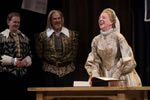 Book of Will, Oregon Shakespeare Festival, Ashland, Oregon. Lauren Gunderson's fictionalized account of Condell andHeminges publishing the First Folio of Shakespeare's plays provided a pleasant couple of hours as we nodded at historical references and winked at Shakespearean insider jokes. Pleasantries gave way to awe at the end of this Christopher Liam Moore–helmed production when, at Anne Hathaway's instruction, the actors began reading the plays. The wall of the theater's tiring house came to life with vintage footage of Oregon Shakespeare Festival productions, which gave way to common people reciting lines, which gave way to non-English-speaking people speaking the lines. Then, "Exeunt," Heminges said. Lights out. I had to gather up my jaw before I could even applaud.
Book of Will, Oregon Shakespeare Festival, Ashland, Oregon. Lauren Gunderson's fictionalized account of Condell andHeminges publishing the First Folio of Shakespeare's plays provided a pleasant couple of hours as we nodded at historical references and winked at Shakespearean insider jokes. Pleasantries gave way to awe at the end of this Christopher Liam Moore–helmed production when, at Anne Hathaway's instruction, the actors began reading the plays. The wall of the theater's tiring house came to life with vintage footage of Oregon Shakespeare Festival productions, which gave way to common people reciting lines, which gave way to non-English-speaking people speaking the lines. Then, "Exeunt," Heminges said. Lights out. I had to gather up my jaw before I could even applaud.
 The Great Society, Arena Stage, Washington, D.C. Jack Willis is LBJ as he reprised the role he originated in All the Way. He portrayed Johnson's disintegration as well as he did his moral courage and political verve. At his side, Bowman Wright got us inside Martin Luther King's overreach, John Scherer unleashed a ferocious Bobby Kennedy, and Cameron Folmar did delectable double-duty as George Wallace and Richard Nixon. That Robert Schenkkan's sequel to his stellar All the Way was not as entertaining nor as focused as the first installment of the LBJ story may be form mirroring content. The Great Society covers more ground, more time, and more outsized personalities joining the political fray while Lyndon Johnson begins to lose his way.
The Great Society, Arena Stage, Washington, D.C. Jack Willis is LBJ as he reprised the role he originated in All the Way. He portrayed Johnson's disintegration as well as he did his moral courage and political verve. At his side, Bowman Wright got us inside Martin Luther King's overreach, John Scherer unleashed a ferocious Bobby Kennedy, and Cameron Folmar did delectable double-duty as George Wallace and Richard Nixon. That Robert Schenkkan's sequel to his stellar All the Way was not as entertaining nor as focused as the first installment of the LBJ story may be form mirroring content. The Great Society covers more ground, more time, and more outsized personalities joining the political fray while Lyndon Johnson begins to lose his way.
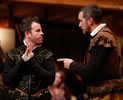 Rosencrantz and Guildenstern Are Dead, American Shakespeare Center, Blackfriars Playhouse. Form informed content in this Actors' Renaissance Season staging of Tom Stoppard's classic play. With the actors directing themselves in repertory with William Shakespeare's Hamlet, John Harrell (Guildenstern), Chris Johnston (Rosencrantz), and David Anthony Lewis (The Player) captured the thematic essence of Stoppard's play: Rosencrantz and Guildenstern exist only because we are watching them, but, in turn, we exist only because we are watching them. Philosophical naval-gazing aside, Harrell and Johnston plus Lewis delivered Stoppard's lines with acute expertise in meaning and timing, making this the funniest version of this play I've seen.
Rosencrantz and Guildenstern Are Dead, American Shakespeare Center, Blackfriars Playhouse. Form informed content in this Actors' Renaissance Season staging of Tom Stoppard's classic play. With the actors directing themselves in repertory with William Shakespeare's Hamlet, John Harrell (Guildenstern), Chris Johnston (Rosencrantz), and David Anthony Lewis (The Player) captured the thematic essence of Stoppard's play: Rosencrantz and Guildenstern exist only because we are watching them, but, in turn, we exist only because we are watching them. Philosophical naval-gazing aside, Harrell and Johnston plus Lewis delivered Stoppard's lines with acute expertise in meaning and timing, making this the funniest version of this play I've seen.
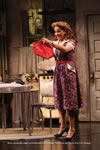 The Panties, The Partner, and The Profit, Shakespeare Theatre Company, Washington, D.C. This David Ives-written, Michael Kahn–directed outing doesn't match the brilliant fun of their three previous collaborations for the Shakespeare Theatre Company (The Liar, The Heir Apparent, The Metromaniacs). Ives' rewriting of Carl Sternheim's turn-of-the-20th century German trilogy tends to wander in the comic wilderness, and Kahn's direction lacks the realistic unreality of the previous plays. This production lands here courtesy of the mesmerizing performance of Kimberly Gilbert as Louise Mask, injecting subtle-yet-incredible poignancy into lines she's delivering with shrill naiveté. I've always been a Gilbert fan, but she's never wowed me as much as she did with this performance.
The Panties, The Partner, and The Profit, Shakespeare Theatre Company, Washington, D.C. This David Ives-written, Michael Kahn–directed outing doesn't match the brilliant fun of their three previous collaborations for the Shakespeare Theatre Company (The Liar, The Heir Apparent, The Metromaniacs). Ives' rewriting of Carl Sternheim's turn-of-the-20th century German trilogy tends to wander in the comic wilderness, and Kahn's direction lacks the realistic unreality of the previous plays. This production lands here courtesy of the mesmerizing performance of Kimberly Gilbert as Louise Mask, injecting subtle-yet-incredible poignancy into lines she's delivering with shrill naiveté. I've always been a Gilbert fan, but she's never wowed me as much as she did with this performance.
Eric Minton
December 31, 2018
Comment: e-mail editorial@shakespeareances.com
Start a discussion in the Bardroom



 Find additional Shakespeareances
Find additional Shakespeareances